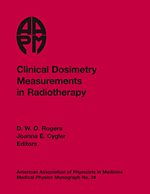
#34 Clinical Dosimetry Measurements in Radiotherapy (2009 AAPM Summer School)
Author: D.W.O. Rogers and Joanna E. Cygler, EditorsISBN: 9781936366118
Published: 2009 | 1112 | Softcover
Price: $ 72.95 was 145.00
Canadian Medical Physics Newsletter | July 2010
This hardcover publication is the monograph of the 2009 AAPM summer school. It is a lengthy volume (over 1100 pages) that covers a wide range of topics under the general umbrella of clinical dosimetry. It is presented in 32 chapters and 2 appendices. The print is high quality and easy to read, however the figures in the document range in quality from excellent to quite poor (usually due to the fact that they are reproductions from earlier publications). Each chapter contains an extensive reference list and a series of problems for which answers are provided in one of the appendices. The text and figures are conveniently available electronically on the accompanying CD and the lectures from the summer school are also available on AAPM’s website.
The work begins with a historical overview of dosimetric measurements and calibrations and is followed by two chapters covering basic physical interactions of radiation, quantities relevant to dosimetry and cavity theory. Subsequent chapters build on this foundation to describe the physics of TG-51 and its clinical implementation. Three chapters are devoted to brachytherapy dosimetry (calculations and measurements). Eleven chapters cover a wide range of radiation detection instrumentation (ionization chambers, radiochromic and radiographic film, TLDs and OSLs, diamond detectors, diodes, MOSFETs, gel and chemical dosimeters and plastic scintillators). The remaining chapters cover an array of topics including kilovoltage x-ray dosimetry, electron dosimetry, primary standards of measurement, instrument calibration, quality assurance in clinical dosimetry, IMRT dosimetry, small field dosimetry, hadron dosimetry and uncertainties in dosimetric measurements.
One of the highlights of the work is the description of the physics of TG-51 and its clinical implementation. As Dave Rogers states, this “is a long-overdue effort to document and explain, in a single place, as much of the physics and computational details behind TG-51 as reasonable”. This collection of chapters (including the underlying cavity theory) is extremely informative and well written. It goes into significantly more detail than a number of standard textbooks. The medical physics community will benefit greatly from the effort put into compiling this information.
The chapters on radiation detectors also provide a wealth of information on the principles of operation, applications and limitations of each detector, as well as correction factors the user must be aware of. The volume of information presented can appear daunting, however the text is well segmented which allows the reader to locate appropriate subsections with ease.
A few chapters make for challenging reading either because they do not stray far from previously-published material (i.e. kilovoltage dosimetry) or because they provide a level of detail that is likely to interest mainly those with an active research interest in the field (i.e. reference-quality brachytherapy dosimetry). Nonetheless, the book benefits from the inclusion of these chapters.
This book will serve as an excellent reference for any practicing radiation oncology medical physicist. The variety of topics covered and the quality of writing make it a valuable resource. The level of detail offered in many areas, and particularly in the TG-51 physics sections, likely exceeds that found in most didactic graduate courses. As such, medical physics residents in this field who take the time to digest this work will benefit from a very strong theoretical foundation in the area of clinical dosimetry. These individuals will certainly also value this text as they prepare for their certification exams! In summary, this book deserves the status of “must have” within the field of radiation oncology medical physics.
Alasdair Syme, Ph.D.
Cross Cancer Institute
Edmonton, AB Canada


